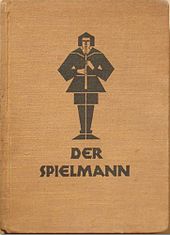The minstrel
Along with the Zupfgeigenhansl, the minstrel is the oldest and highest-circulation songbook of the German wandering bird movement from the beginning of the 20th century.
history
The book has its origins in a song book for youth and people named on July 20, 1914, a collection of folk, hiking and church songs, edited by Klemens Neumann , co-founder of the Quickborn Association . Initially intended as an internal songbook for the Catholic Quickborn youth founded in Neisse in Upper Silesia and published in two separate editions, it quickly enjoyed great popularity. In 1915 a supplement was published, the second edition in 1918, the third in 1919, the fourth edition in 1923 and the ninth edition in 1928.
From the 3rd edition in 1920, the collection was given its final name Der Spielmann. Songbook for youth and people. The proceeds from the sale of this songbook went to the purchase and expansion of Rothenfels Castle in what is now the Main-Spessart district as an educational and meeting place for the Quickborn. The publisher or place of publication is Burg Rothenfels am Main in the imprint . Publisher Deutsches Quickbornhaus stated.
Starting with the 1922 edition, a greater number of songs from the 15th, 16th and 17th centuries were added to the collection and a completely new section with sacred songs was added. This was compiled by Hermann Müller , Paderborn, one of the best connoisseurs of the hymn of the time. The graphic design was done by the expressionist church painter Anton Wendling .
The repertoire was revised again for the 1928 edition. About 80 songs were re-recorded, others deleted; Many pure hymns were replaced by Christmas carols , songs for festive occasions and spiritual ballads . From the 1928 edition onwards, the musical companions from the Quickborn movement, Franz Liebich from Landeck in Silesia, and Nini (Adeline) Dombrowski , sister of the composer Hansmaria Dombrowski and music teacher at the Upper Lyceum Hedwig School in Neisse , worked for the seriously ill Klemens Neumann (he did not experience the new edition) listed; these two took over the editing and editing of the subsequent editions until the end of the 1950s.
In 1930 the octave book was first published by Matthias Grünewald Verlag Mainz with a print run of 20,000 copies (320 pages). The striking title vignette, which has remained unchanged across all Grünewald editions, as well as the illustrations for the individual sections were created by the Frankfurt wood cutter and graphic artist Walter Clemens Schmidt . Around this time, the book also received ministerial approval for use in school teaching in the province of Silesia . For this purpose, among other things, Der Spielmann was supplemented in 1930 by the piano book zum Spielmann, published by Hansmaria Dombrowski. It was characterized by easy-to-play sentences that left room for imaginative interpretations.
The red-blue linen binding, which was still red-blue in 1930, was changed to the striking brown-black from the following edition in 1932 and retained unchanged until the last edition. In 1932 the 151st – 165th A thousand printed, now with 360 pages.
From 1947 onwards several post-war editions appeared, in 1959 the book reached a circulation of 233,000 copies, in the late 1960s the circulation exceeded the quarter of a million. The last edition, the 22nd, appeared in 1978 (no longer in linen, but in an orange-colored flexible plastic cover, but still with the well-known and distinctive vignette). According to the Matthias Grünewald publishing house, no further reprint is planned.
The repertoire
The book is divided into different subject areas, with the rubrics changing even more frequently in the first few years, until a practicable order had emerged. In the issues from 1930, there are relatively constant nature songs, songs of love , farewell songs, hiking songs , Landsknechts- and soldiers' songs , Funny songs, dance songs, ballads, morning and evening songs , hard songs, Sacred Songs - always with special attention Silesian song good.
literature
- Klemens Neumann, Franz Liebich, Nini Dombrowski (eds.): The minstrel. Songbook for youth and people. Grünewald, Mainz 1932. New edition: 1947. 22nd edition: 1978, ISBN 3-7867-0163-6 .
- Joachim Dennhoff: Piano and music book for the "Spielmann": A selection of the original movements by Hansmaria Dombrowski (1897 to 1977). Laumannsche Verlagsbuchhandlung, Dülmen 2001, ISBN 3-89960-221-8 .
- Hermann Hoffmann: Prof. Klemens Neumann - The minstrel of God. Franke, Breslau 1939.
- Hans Maier : Neumann, Klemens Andreas. In: New German Biography (NDB). Volume 19, Duncker & Humblot, Berlin 1999, ISBN 3-428-00200-8 , p. 157 f. ( Digitized version ).
- Joseph Thamm: Nini Dombrowski †. In: Neisser Heimatblatt. 13th vol., No. 80, p. 11.
Web links
- Songs / content Der Spielmann at deutscheslied.com


